IntMath Newsletter - cookies, heartbeats and Fourier
By Murray Bourne, 30 Mar 2010
30 March 2010
In this Newsletter:
1. Cookie jars and tessellations
2. Your heartbeat and Fourier Series
3. IntMath Poll - Math and Real-world Problems
4. Latest IntMath Poll - Who are you?
5. Math Awareness Month April 2010
6. Latest from the Math Blog
7. Final thought – Commitment to excellence
Welcome to all the new subscribers! The IntMath Newsletter goes out to over 7,500 people in 165 countries.
1. Cookie jars and tessellations
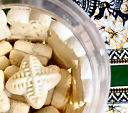 |
How can we neatly stack cookies into a circular jar? This topic is related to "tessellations". Math is not only about algebra - visual design and packaging also use mathematical techniques. See more in: Cookie jar math |
2. Your heartbeat and Fourier Series
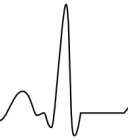 |
I recently had an ECG done and found it very interesting. This article explains how we can model the human heartbeat with a mathematical expression, using Fourier Series. |
3. IntMath Poll - Math and Real-world Problems
The Feb-Mar 2010 IntMath Poll revealed around 70% of students get little idea why they need to study math during their lessons. The question and responses were:
I get a good understanding of how math is applied to real world problems...
In most lessons: 31%
In some lessons: 29%
Rarely: 24%
Never: 17%
Total votes: 2200
Students need to see how to use math, otherwise it can become a painful academic exercise!
Of course, many of us like math for its own sake, but that's not the feeling of many students.
4. Latest IntMath Poll - Who are you?
A new poll is up and asks readers whether they are students or instructors, or maybe retired people wanting to learn.
You can respond on any page in IntMath.com (look in the right margin when you get there).
5. Math Awareness Month - April 2010
April is Math Awareness Month. This year, the theme is "Mathematics and Sport".
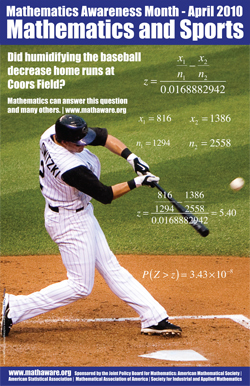
You may also be interested in my article on: Baseball bat math
6. Latest from the Math Blog
7. Final thought – Commitment to excellence
Since this Newsletter has a sports theme, we'll finish with a gem from a famous football coach:
The quality of a person's life is in direct proportion to their commitment to excellence, regardless of their chosen field of endeavor. [Vince Lombardi]
Until next time, enjoy whatever you learn.
See the 4 Comments below.
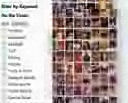
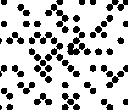

30 Mar 2010 at 9:46 pm [Comment permalink]
Your Heartbeat and Fourier series was a v interesting article. i enjoyed.
31 Mar 2010 at 2:01 am [Comment permalink]
Dear Sir,
Your Heartbeat and Fourier series was very interesting and wonderful.It made me appreciate the system of mathematical modeling could give solutions to real world problems.This gives me passion to focus on my la place and Z transform.
31 Mar 2010 at 2:48 am [Comment permalink]
Please be kind enough and give me the formula for lung volume air exchange. My lung capacity is 2 liters. Each exhalation expels 100 mls and brings in 100 mls of fresh air .This means that the remaining 'stale ' air is diluted with the incoming fresh air .How long does it take for the 2 liters to be replaced with fresh air assuming 12 respiration per minute. Can this problem be solved by using integrals or derivatives? Thank you very much.
3 Apr 2010 at 5:29 pm [Comment permalink]
Adam, the situation is not as simple as you indicate. Your blood vessels release stale air all the time into your lungs, so you would need to consider this as well.
These problems are solved using Differential Equations and you need to set up a system of input and output.
I'll add this topic to the long list of request for a future IntMath Newsletter.